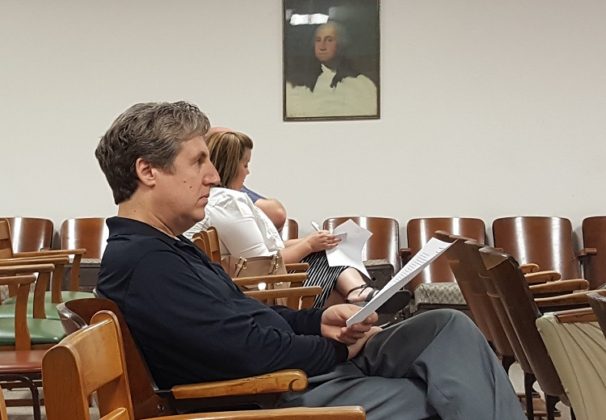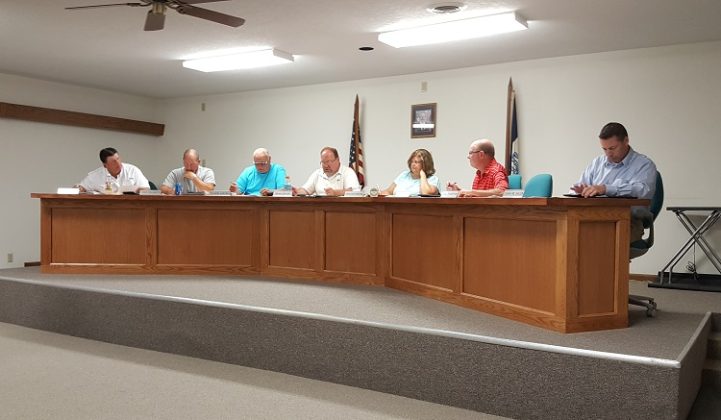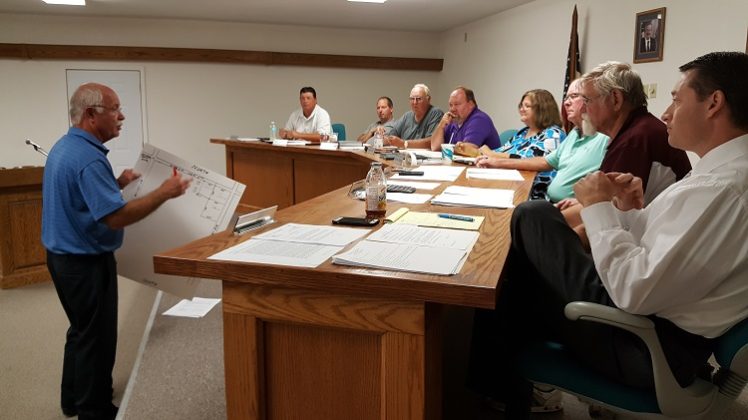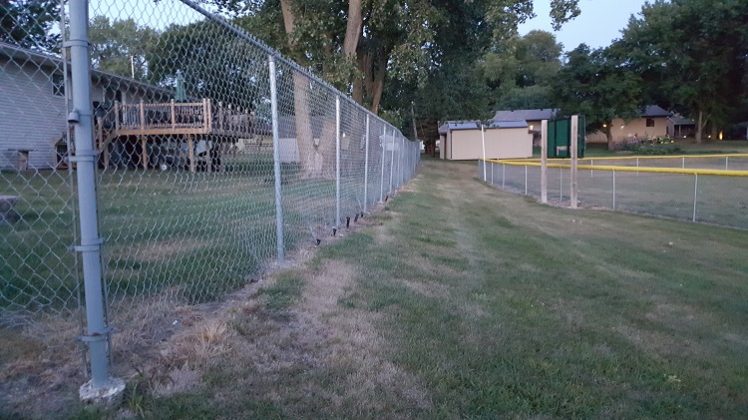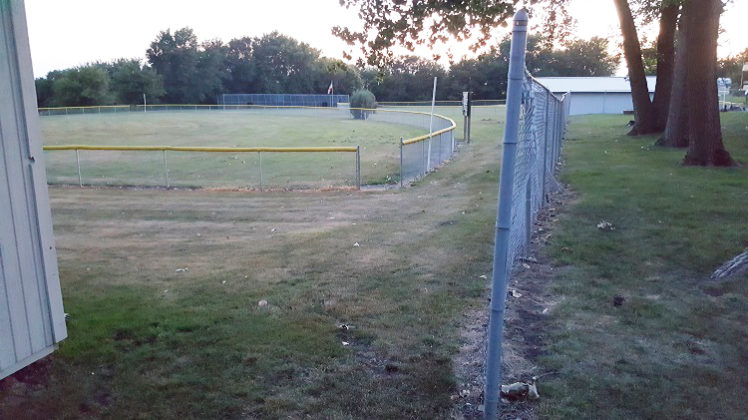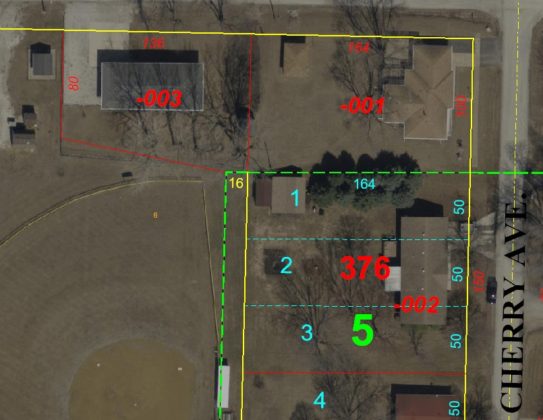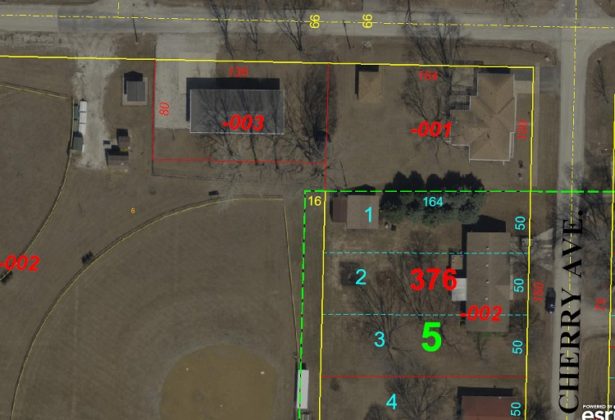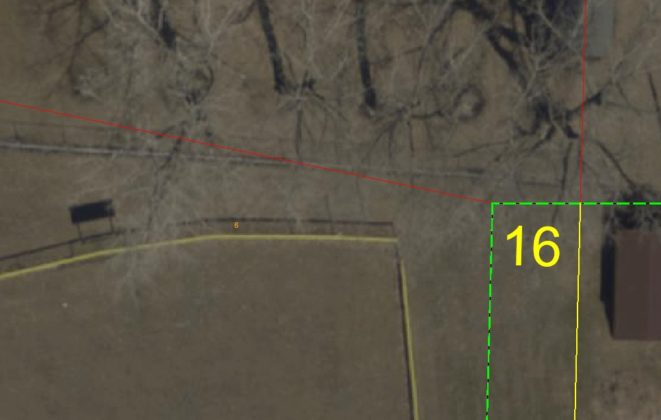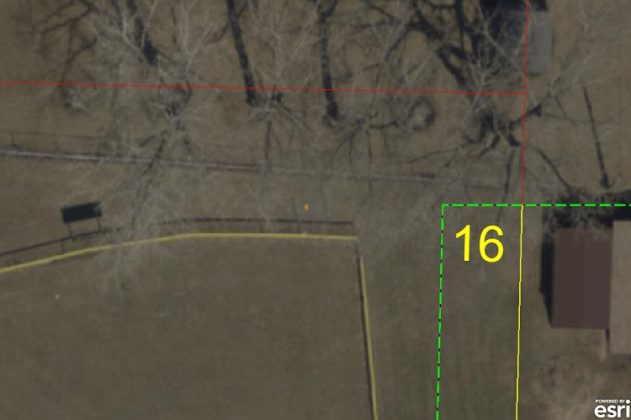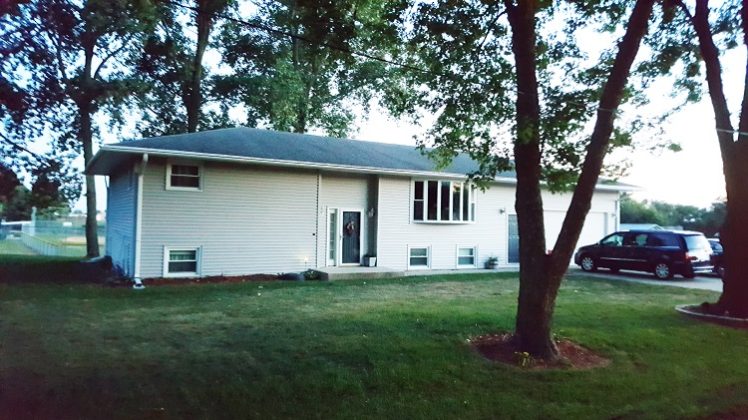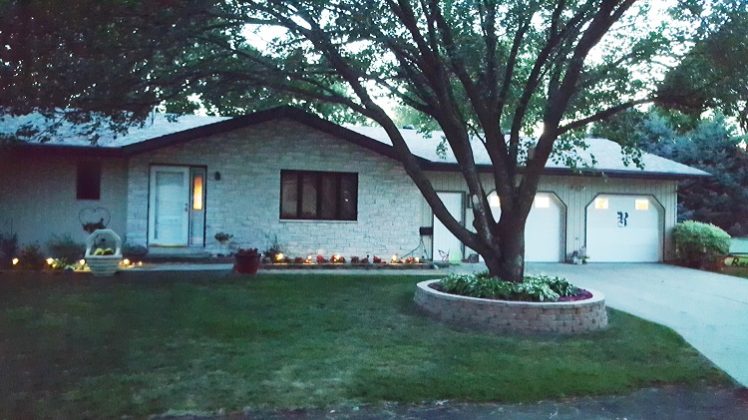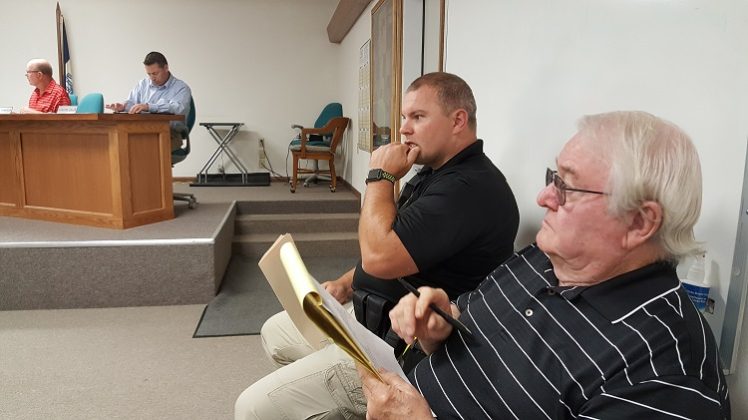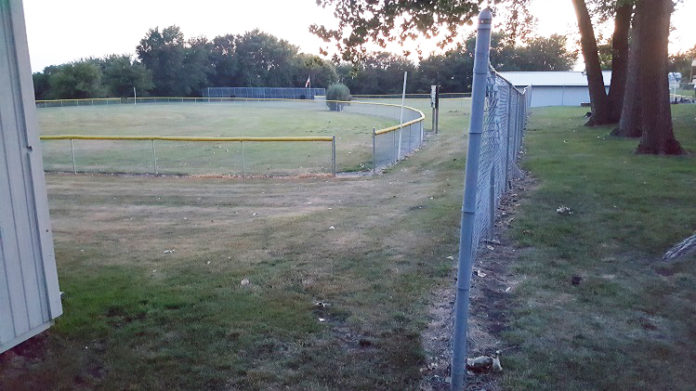
A brewing legal dispute between two Woodward property owners over a fence believed to lie partly on each one’s land and partly on city property has possibly been calmed — and possibly enflamed — by means of a simple expedient: a fresh survey of the properties.
Human memory is frail and record keeping faulty, and no one seems to know for certain when the fence in question was installed on the north side of the ballfields at W. Fifth Street and Cherry Avenue.
Both property owners — Michael Ramsey 506 Cherry Ave. and Philip Creese of 405 W. Fifth St. — have come before the Woodward City Council seeking an answer to the boundary question. Creese and his wife, Colleen Creese, gave their view of the fence issue at the July 10 council meeting, and Ramsey appeared Aug. 14.
“We’re not sure at this time who owns that particular strip of fence,” Phillip Creese told the council in July 10. “I nor the other two owners of the property, both my sisters, have no recollection of us ever putting it up and I, being my father’s workhorse, would have been the one digging the holes. So we’re still in a little bit of a conundrum trying to figure out if it’s our fence or city fence.”
Woodward Mayor Brian Devick noted the Creese lot “has a very unusual shape to it. It doesn’t match anything else in town. It’s not square.” An aerial map of Aug. 14, provided by Dallas County GIS, showed the unusual shape:
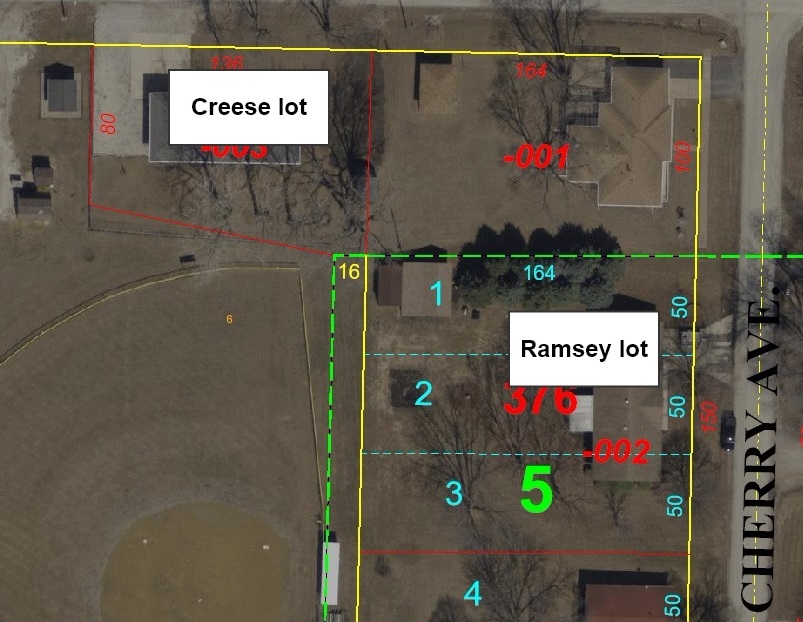
A closer look at the Aug. 14 GIS map shows the western portion of the fence in question lying on city property and the eastern portion crossing Creese property and ending either on Ramsey property or on the corner lot owned by Mary Jo Wickett of 502 Cherry Ave.

Devick asked Creese at the meeting whether he was asking the city to remove the fence.
“No, we’re just trying to figure out who owns it,” Creese said. “That way,” added Colleen Creese, “we know legally what we’re responsible for versus any other entities.” She said they were “coming here to ask for an easement for the property or an easement for the fence in the back southwest corner of the property, assuming that the fence is ours.”
“I can tell you the Creese family has maintained it since 1984, when the home was purchased,” Phillip Creese said. “I don’t have any reason that we would take that fence out. We don’t want to take any sort of action, given the situation, until we can validate whether that’s truly fencing that’s owned by the Creese family or not because the people who potentially could have put it there are no longer here to validate.”
The “situation” referred to by Creese involves a request from his neighbor, Ramsey, that Creese remove the portion of the fence believed to lie on Ramsey’s property. Several members of the Woodward City Council said they would be willing to grant the Creeses an easement but not until they resolve the matter with their neighbor.
“The only easement we will grant is for what is on city property,” Devick said. “If we’re talking legal stuff, and you’re wanting to pursue legal matters, the last thing we want to do is muddy that by putting an easement on something that’s going to court. I don’t think there’s any problem granting an easement for where the fence is sitting on city property, but I don’t think the council’s comfortable and I don’t know that I’m comfortable doing anything until you resolve the other issues first.”
Council member Dave Luke asked the Creeses about their dispute with Ramsey.
“I don’t have heartburn at all with the request about the fence,” Luke said. “I realize that there’s a property dispute between you and the neighbor on the very far east end of that fence. When we’re talking about the fence, the fence as a whole, that’s what I have to consider and have to look at. If you want to go back to where your fence stops and is no longer on city property and then remove all that fence, okay, but we’re talking about the whole fence. So I ask again: Have you guys come to an agreement with your neighbor with the portion of the fence that’s on his property?”
“Not yet,” said Colleen Creese. “We have consulted legal assistance on this because we’ve not yet been shown proof. There’s also a state law that protects as us as well with that property. So as of right now, we have not come to resolution on the eastern portion of that fence.”
Luke also asked whether the Creese property was surveyed.
“It’s on our list to do,” Colleen Creese said, “depending on the results of this meeting. We’ve hired legal counsel to help us as well.”
“If I was in you kids’ shoes,” Luke said, “I’d really need to know because we’re not all going to live forever and your kids, you don’t want them to go through what you’re going through, so you probably should just go get the survey, and then you would know without a shadow of a doubt where your property starts and ends.”
The council resolved to do nothing pending a survey of the property.
“I think the city wants to play this cautiously,” Devick said, “and is saying you need to resolve your issues before we move forward.”
Woodward City Attorney DuWayne Dalen also encouraged a survey.
“If the city is going to give an easement,” Dalen said, “I want a good legal description that the city’s going to be given to make sure any easement we may or may not give is accurate.”
The Creeses did not attend the Aug. 14 council meeting but during the month since the previous meeting, their attorney communicated with the city of Woodward.
“I’m holding in my hand,” Devick told the council, “a copy of a letter from an attorney representing the [Creeses], who is claiming not only ownership to that [fence] but ownership to the land that it sits on, and most of that fence is on city property.”
The mayor recommended turning the whole matter over to the city attorney.
Considering, Devick said, that “the majority of the fence is on city ground and was installed and put in by the city, then when an attorney is claiming ownership of that land on behalf of a property owner and ownership of that fence on behalf of a property owner, then as far as I’m concerned, and you guys can decide, but as far as I’m concerned, at that point we give it to our city attorney and say, ‘Uh-uh. It’s the city’s and the city’s right to do what they want to with it.'”
All eyes bent toward the city attorney.
“It’s got to be surveyed, number one,” Dalen said, “because you’ve got to know where the true lot lines are.”
The Creeses were absent from the August meeting, but their neighbor Mike Ramsey was present, and he brought along some lot lines of his own. He said he had his property surveyed and had also acquired a copy of a quit claim deed for the Creese property, including a legal description, as well as copies of real estate contract installments for the Creese property.
“I don’t think this fence is on their property,” Ramsey told the council. “I don’t think none of it is.”
Possibly as a result of Ramsey’s survey, the Creese property’s lot lines on the aerial maps of Aug. 23 differ from the lines on the maps of Aug. 14:
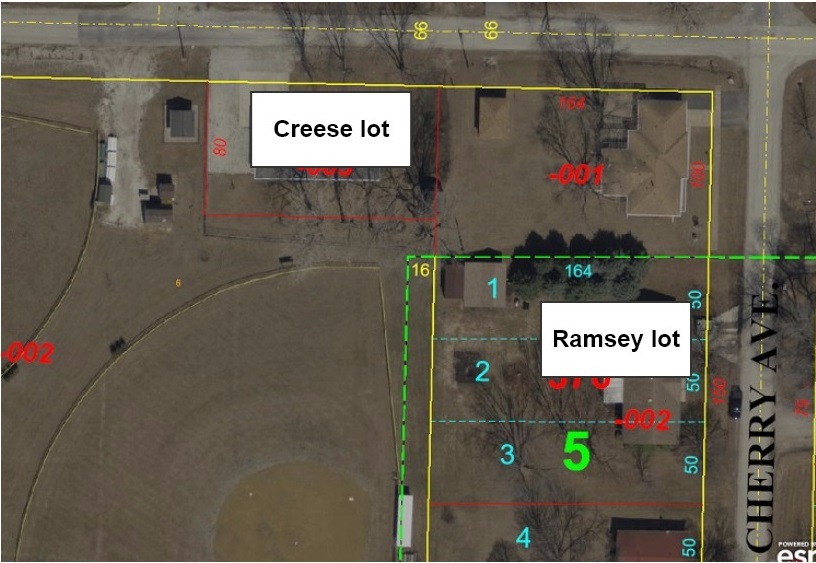
Luke said he also did some research during the course of the month and inquired with a certain Mr. Gunderson, one of the Woodward tribal elders, who described the origin of the fence.
“I’m telling you guys the fence is ours,” Luke said. “Phillip Jr. grew up there and is assuming that that fence is his.”
Ramsey was equally certain in his opinion. “It’s not even remotely close,” he said. “You own the fence. You own four trees and a burn pile.”
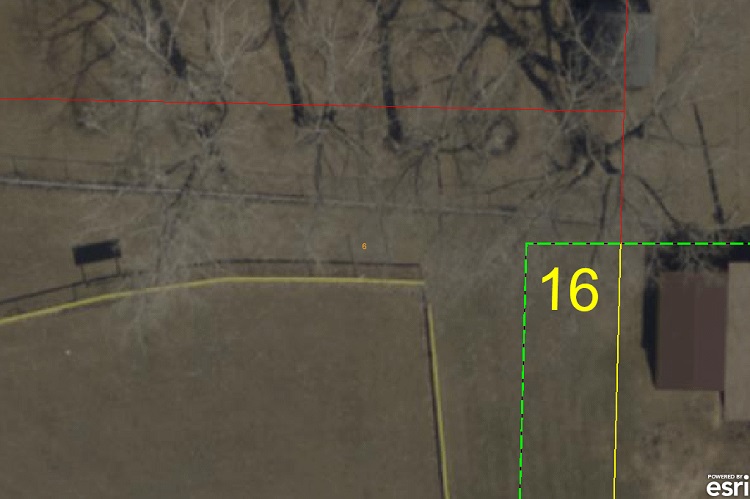
The lines appeared to be clear and distinct, but Dalen said further legal complications could arise.
“In these cases, there’s such a thing as boundary by acquiescence,” he said. “There’s such a thing as adverse possession. They’re talking about filing a quiet claim action. There’s three or four different legal theories that can be argued in a case like this because — look at how hard it was for Dave to figure out where in the world this fence came from.”
According to online sources, acquiescence is a legal concept that determines the boundary line between two properties and overrules the boundary listed in the deeds. If the law of acquiescence applies, one property owner loses title to some amount of land, and the other property owner gains it.
The concept of adverse possession applies to the occupation of land to which another person has title with the intention of possessing it as one’s own, and an action to quiet title is a lawsuit brought in order to establish a party’s title to property against anyone and everyone and thus to “quiet” any challenges or disputed claims to the title.
“We could spend a lot of money to argue about a fence that we don’t care about just to prove that it’s on city property,” said Woodward City Council member Craig DeHoet. “The only real issue here is that last eight-foot section, so if we would give that property owner the easement for the fence area on the understanding that they remove that last eight feet, then all of this goes away, right?”
Dalen said, “Once we figure out where our property is, there’s still the issue, I’m afraid, of the Ramseys and the Creeses. That could be a whole separate court case of those two figuring out what they’re going to do between their two properties.”
Luke said he was willing to compromise.
“In all honesty,” he said, “if they wanted that property and they wanted to pay property taxes on that extra property and they want to leave the fence there, I’ll go for that. You can have it, but you’re going to pay property taxes on it and if not, we want our property back.”
In a state of some perplexity, the council directed the mayor and the city attorney to draft a reply to the Creeses’ attorney and to work to resolve the issue.
“The fence is on my property,” Ramsey said, “but yet I’m the villain in this whole thing. It just frustrates me. They want to take my property and say, ‘It’s ours,’ and that’s crap.”









